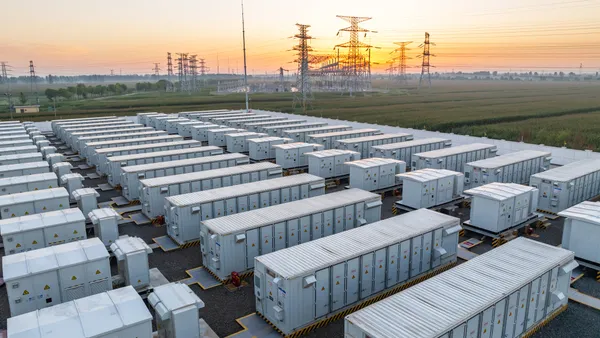Dive Brief:
- States and municipalities can use a model ordinance framework published by the American Clean Power Association to develop regulations for permitting, siting, safety, environmental compliance and decommissioning of energy storage systems, ACP said Thursday.
- The framework draws on guidance from national energy laboratories, existing state laws and local regulations, and national fire safety standards such as UL 9540 and NFPA 855, ACP said.
- The framework “represent[s] the most expansive and meaningful efforts to date in promoting the adoption of the latest national safety standards, as well as the development of rigorous and reasonable rules for the development and operation of battery energy storage resources,” ACP Chief Policy Officer Frank Macchiarola said in a statement.
Dive Insight:
ACP released the new model ordinance framework less than a week after an explosive fire at an Aricell factory near Seoul, South Korea, killed 22 workers and reignited concerns about lithium-ion battery safety.
While faulty cells and modules are responsible for some battery explosions and fires, a joint study released earlier this year by TWAICE, the Electric Power Research Institute and the Pacific Northwest National Laboratory found that most have other causes. These include installation issues made worse by incompatible wiring, HVAC and fire suppression systems, the report said.
“A variety of stakeholders” helped ACP develop the model ordinance, including fire safety experts, current and former fire officials and energy storage developers, operators and manufacturers, said Noah Roberts, ACP’s senior director of energy storage.
ACP has in the past provided siting and permitting guidance to state and local governments, but the model ordinance is “a first of its kind policy” that “represents a greater step by incorporating the principles of NFPA 855 and other best practices and standards into the specific guidance provided in the model,” Roberts said.
NFPA 855, which Roberts called “the industry standard practice” for fire safety, mandates “design, installation, commissioning, operation, maintenance and decommissioning” requirements for energy storage facilities, including maximum energy and unit spacing, according to ACP. It also details required regulatory filings such as hazard mitigation analyses, emergency response plans and safety system specifications.
UL 9540 details specific safety standards for energy storage equipment under NFPA 855, while the related UL 9540A standard details fire safety testing requirements for energy storage systems, according to UL Solutions, which oversees the standards.
ACP’s model ordinance is aimed at energy storage systems 1 MW or larger and sets an initial application review period of 30 days or less, after which municipalities must issue written approval or a notice of deficiency.
The model allows battery storage installations that comply with the ordinance’s requirements to be sited in all land use zones, with by-right permitting in agricultural, industrial and commercial areas and discretionary permitting in residential, mixed-use and public/institutional areas.
A by-right or ministerial permitting approval occurs when a proposed land use conforms to the site’s existing zoning and building codes. A discretionary approval requires additional review by local permitting authorities, potentially adding time and expense to the preconstruction period.
The model also lays out decommissioning requirements for energy storage facilities, including a bond or other form of financial assurance from the applicant that is “[not] less than the estimated cost of decommissioning the energy facility, after deducting salvage or recycling value.”
The model ordinance framework can be adopted or incorporated into state laws and local regulations, but “[it] may not be appropriate … to be adopted precisely as it is written” or used as legal advice, according to the model’s preamble. Local governments should seek legal advice and consider modifying the model ordinance’s language “to suit local conditions, comprehensive plans, existing land use and zoning provisions,” the model says.














